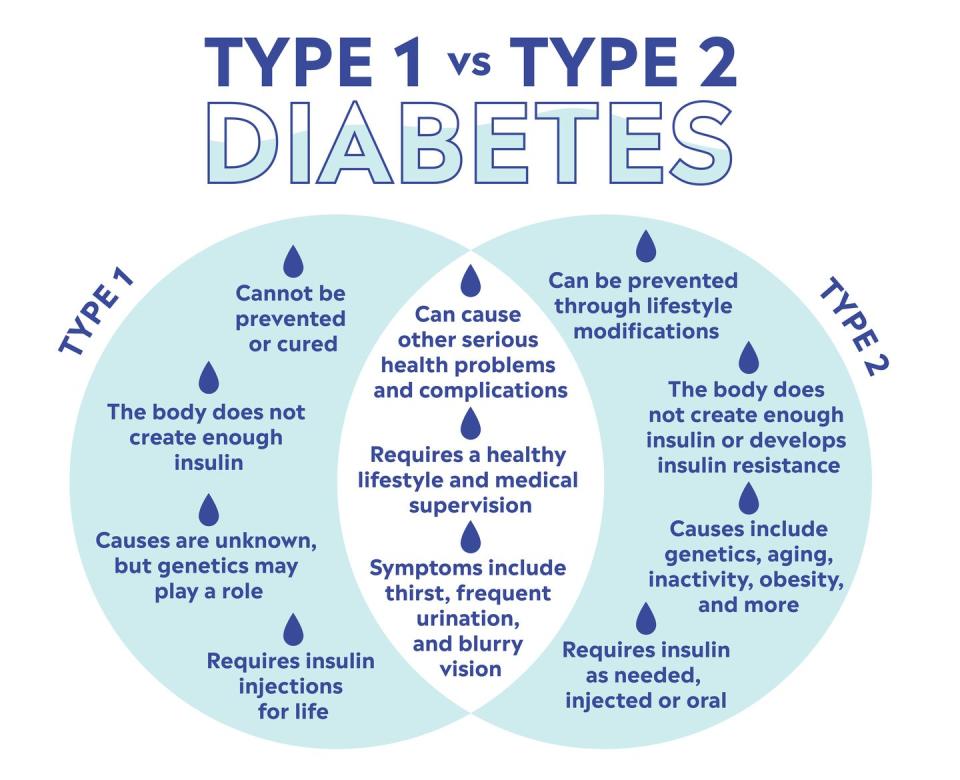Every Important Fact to Know About How Type 2 Diabetes Affects Your Body

Table of Contents
Overview | Causes | Symptoms | Diagnosis | Treatment | Complications | Prevention
What is type 2 diabetes?
The most common type of diabetes, type 2 diabetes is diagnosed when your blood sugar (also called blood glucose) is persistently elevated above the normal range over a long period of time. At the same time, your body either doesn't use insulin properly or doesn't make enough insulin. Our bodies need insulin to move glucose into cells so it can be used for energy.[1]
“The problem is one of supply and demand,” says David Nathan, MD, director of the Massachusetts General Hospital Diabetes Center. “Lots of people can have insulin resistance. But people who have diabetes can't make enough insulin to meet that demand.”[2]
Although type 2 diabetes generally develops in adults 45 and older, the age of onset has dropped as rates of childhood obesity has risen.[3]
If blood sugar levels rise moderately over time, there may be no symptoms of type 2 diabetes. When there are, the symptoms are nonspecific and include increased thirst and urination, blurred vision,
consistent low energy levels, and sometimes weight loss.[4]
More than 30 million Americans live with diabetes, with about 1.5 million new cases diagnosed each year.[5]
What causes type 2 diabetes?
Both lifestyle and genes play a role in type 2 diabetes. The following may increase your risk:
Family history: Having a parent or sibling who has type 2 diabetes
Age: Being 45 or older
Weight: Being overweight or obese, particularly if you have a high hip-to-waist ratio
Inactivity: In addition to helping control weight, regular exercise can help lower blood sugar by increasing insulin sensitivity and uptake of glucose from the blood
Race: African American, Alaska Native, American Indian, Asian American, Hispanic/Latino, Native Hawaiian, or Pacific Islander races have higher rates of type 2 diabetes
Gestational diabetes: A diagnosis with diabetes during pregnancy or giving birth to a baby weighing more than 9 pounds
Polycystic ovary syndrome (PCOS)
High blood pressure
High cholesterol
[6]
What are the symptoms of type 2 diabetes?
Type 2 diabetes can go unnoticed if blood sugar levels elevate slowly over time. Or the symptoms may be so subtle and infrequent that you don't notice them. Be mindful of the following symptoms, which may be signs of type 2 diabetes. If you notice a change in any of these, see your doctor.[7]
How is type 2 diabetes diagnosed?
Because symptoms are nonspecific, most people are diagnosed with type 2 diabetes on the basis of a blood test, Dr. Nathan says. Although your doctor may ask you about symptoms to determine if you have type 2 diabetes, he or she will need a blood test to properly diagnose the condition.
There are three main tests used to diagnose type 2 diabetes. The fasting blood sugar test and A1C test are the most commonly used, though some doctors will use the random blood sugar test or a test called the oral glucose tolerance test. For any of these tests, let your doctor know if you are on any medication, as steroids can temporarily raise blood sugar levels and atypical antipsychotics are associated with an increased risk of type 2 diabetes. “This is why the A1C test can be useful, as it's not vulnerable to fluctuations,” Dr. Nathan says.
Fasting blood sugar test
For a fasting blood sugar test, you fast for at least eight hours. Then your blood is drawn to check your glucose levels. Doctors will use a fasting blood sugar test during annual exams after age 45 or earlier if you have a family history of type 2 diabetes, Dr. Nathan says. The only complication with this test is the fact that you need to fast, so it's recommended to schedule this test in the morning so you don't need to go too long without eating.
A1C
The A1C test, or glycated hemoglobin test, represents your average blood sugar over the past two to three months. This test measures the portion of hemoglobin attached to glucose. Hemoglobin is a protein in red blood cells that carries oxygen to cells. The higher your blood sugar, the more glucose will attach to hemoglobin. An advantage of this test is that your blood can be drawn at any time and you do not need to fast. However, the A1C test isn't for everyone, as it is inaccurate in those with anemia and may also be inaccurate in those of African, Mediterranean, or Southeast Asian descent.
Random blood sugar test
The third test, the random blood sugar test, is similar to the fasting blood sugar test but doesn't require that you fast.
Oral glucose tolerance test
This is the gold standard test to diagnose diabetes. After fasting overnight, your blood will be taken so your doctor can get a measure of your fasting blood glucose level. Then, you will drink and a glass of water containing some sugar. Two hours later, your blood will be tested again.
[8]

How is type 2 diabetes treated?
Type 2 diabetes can initially be managed by lifestyle changes. Behavioral changes such as becoming more active and eating a healthier diet can help to control blood sugar as well as to lose or manage weight if overweight or obese. When these changes are not enough to manage type 2 diabetes, your doctor may prescribe medication or insulin therapy.
Lifestyle changes to treat type 2 diabetes
Exercise
Aim for at least 30 minutes of activity most days of the week. It does not have to be intense and you can break it up over the course of the day. A combination of stretching, aerobic exercise (such as brisk walking, swimming, dancing, or biking) and resistance training (such as yoga, lifting weights of any size, or using resistance bands) may be more effective at controlling blood sugar than doing only one type of activity. If you are new to exercise, start slowly and build up.
Diet
There is no “diabetes diet,” so don't fall prey to fad diets. The key is to reduce calories, added sugar, and starchy foods, and make changes you can live with. Focus on consuming whole vegetables and fruit, whole grains, lean protein, and healthy fats, and drink unsweetened beverages. Talk to a registered dietitian who specializes in diabetes for a plan specific to your needs.
Monitoring your blood sugar levels
Your doctor may ask that you check your blood glucose levels on a regular basis. You can purchase a blood glucose monitor from a drug store to do this. After pricking your finger, you will place a drop of blood on a test strip and then use the monitor to measure the level of glucose in your blood. Another option is to use a continuous glucose monitor (CGM). CGMs measure your interstitial glucose level (the glucose found in the fluid between the cells) via a tiny sensor that gets inserted under your skin. The sensor automatically tests glucose every few minutes and sends the information to a monitor.
[9]
Medications for type 2 diabetes
Metformin
Widely prescribed to treat type 2 diabetes, metformin lowers how much glucose your liver makes and how much glucose you absorb from food. It also improves insulin sensitivity so your body uses insulin more effectively. Note: This medication is not suitable for patients with kidney problems.
Sulfonylureas
These help your pancreas release more insulin. Possible side effects include weight gain and low blood sugar.
Meglitinides
Another group of drugs that help the pancreas secret more insulin, meglitinides work faster than sulfonylureas but their effect lasts for a shorter period of time.
Pioglitazone
This drug helps insulin work well in the muscle. However, side effects include an increase in body weight, fluid retention, and increased risk for heart failure.
DPP-4 inhibitors
This class of medications lowers blood sugar levels by preventing the breakdown of GLP-1, a natural hormone that reduces blood glucose levels. The effects of these inhibitors are modest, but safe for elderly patients and in those with kidney problems.
SGLT2 inhibitors
Sodium-glucose transporter 2 (SGLT2) works in the kidney to reabsorb glucose into the blood. These drugs block that action so that the glucose is excreted when you urinate. However, they increase the risk of urinary tract and genital yeast infections if you don’t drink enough water to flush the sugar in your urine.
Insulin therapy
Injecting insulin on a regular schedule (as determined by your doctor) can help if your body isn't making enough itself. Over time, you may need to increase the amount of insulin you take.
Talk to your doctor about the best treatment plan for you, which may include a combination of lifestyle changes and a combination of medications.
[10]
Complications of type 2 diabetes
Type 2 diabetes can increase the risk of other complications, as “when glucose is high, it gets into tissues that aren't responsive to insulin,” explains Leann Olansky, M.D., an endocrinologist at Cleveland Clinic.[11] “The good news is you can prevent or delay all of these by controlling blood sugars in a more normal range,” Dr. Nathan adds. (See above for treatment options.)
Complications may include heart or kidney disease, eye diseases (including retinopathy, cataracts, and glaucoma, which can lead to blindness), fungal or bacterial infections of the skin, and diabetic neuropathy, a type of nerve damage that can cause pain or numbness in the feet, or problems in you urinary tract, digestive system, sex organs, or circulatory system.[12]

How to prevent type 2 diabetes
Even with a family history, type 2 diabetes can be prevented with some basic lifestyle changes. People who followed the lifestyle intervention model of the Diabetes Prevention Program (which is sponsored by the National Institute of Diabetes and Digestive and Kidney Diseases) reduced the risk of type 2 diabetes by 58 percent after three years compared to patients who took a placebo.[13]
The goal of this program was to lose weight, and participants do this by cutting back on calories and exercising more. You can follow the same interventions to help reduce your risk:
Reduce your calories
“Caloric restriction alone can have very sudden, big effects on diabetes. We know that just cutting calories improves your ability to make insulin and respond to it,” says diabetes physician Adrian Vella, M.D., head of Mayo Clinic endocrinology research.[14] “We presume this applies to pre-diabetes too.” Follow a diet that you can live with, as no on diet is best. “Ultimately calories trumps the actual content,” Dr. Vella says.
Lose weight, if you need to
According to a 15-year follow-up of the Diabetes Prevention Program, losing 5 to 7 percent of your body weight may prevent or delay diabetes.
Be active
Aim for 30 minutes of exercise at least five days a week.
Get screened regularly
Since type 2 diabetes can present without symptoms, get your blood sugar tested at your annual exam once you are 45 years old, or sooner if you have a family history.
Sources
[1] https://medlineplus.gov/ency/article/000313.htm
[2] David Nathan, M.D., director of the Massachusetts General Hospital Diabetes Center
[3] https://www.ncbi.nlm.nih.gov/pmc/articles/PMC1466782/
[4] https://www.cdc.gov/diabetes/basics/symptoms.html
[5] https://www.cdc.gov/diabetes/basics/quick-facts.html
[6] https://www.cdc.gov/diabetes/basics/quick-facts.html
[7] http://www.diabetes.org/diabetes-basics/symptoms/
[8] https://www.niddk.nih.gov/health-information/diabetes/overview/tests-diagnosis, https://www.cdc.gov/diabetes/basics/getting-tested.html, https://medlineplus.gov/a1c.html
[9] https://www.cdc.gov/diabetes/managing/index.html, https://www.niddk.nih.gov/health-information/diabetes/overview/managing-diabetes/4-steps#page4
[10] http://www.diabetes.org/living-with-diabetes/treatment-and-care/medication/?loc=lwd-slabnav, https://www.niddk.nih.gov/health-information/diabetes/overview/insulin-medicines-treatments
[11] Leann Olansky, M.D., an endocrinologist at Cleveland Clinic
[12] https://www.niddk.nih.gov/health-information/diabetes/overview/preventing-problems
[13] https://www.ncbi.nlm.nih.gov/pmc/articles/PMC1282458/
[14] Adrian Vella, M.D., head of Mayo Clinic endocrinology research
You Might Also Like

